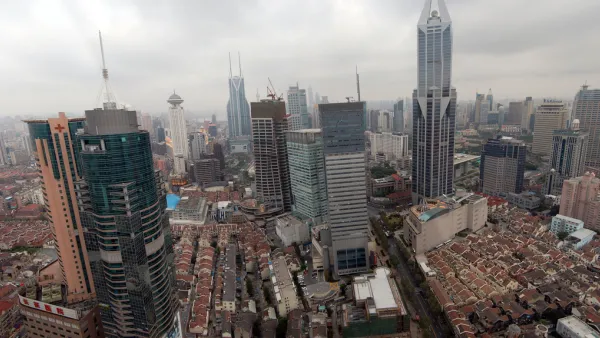Research suggests China’s current urbanization policy forgoes $2 trillion in growth over the next ten years. That is, unless the government funnels even more migrants into major population centers and develops for density.
Top Chinese economists have joined the chorus supporting dense urban development. Current Beijing policy, they argue, hasn’t done enough to grow the most populous cities. The prevailing policy seeks to limit overcrowding and environmental impacts in cities like Beijing, Shanghai, Guangzhou, and Shenzhen by funneling migrants into smaller cities, generating sprawl.
Proponents of the Chinese mega-city want to build up rather than out, citing the higher economic efficiencies of cities like Tokyo and Seoul. From the article: “An additional 4.2 million people can be added to Guangzhou and 5.3 million to Shenzhen if those cities had the same population density as Seoul, according to a March report by the World Bank and the State Council’s Development Research Center.”
The key to making these densities work is upgraded urban infrastructure, transportation in particular. By focusing on dense development instead of sprawl, China could save “$1.4 trillion from a projected $5.3 trillion in infrastructure-spending needs during the next 15 years.” This money could then go into mass transit and other density-friendly techniques, remedying China’s infamous smog problem in the process.
Despite these calls, Beijing seems poised to uphold limits on mega-city growth.
FULL STORY: Why China's Gigantic Cities Are Just Too Small

National Parks Layoffs Will Cause Communities to Lose Billions
Thousands of essential park workers were laid off this week, just before the busy spring break season.

Retro-silient?: America’s First “Eco-burb,” The Woodlands Turns 50
A master-planned community north of Houston offers lessons on green infrastructure and resilient design, but falls short of its founder’s lofty affordability and walkability goals.

Delivering for America Plan Will Downgrade Mail Service in at Least 49.5 Percent of Zip Codes
Republican and Democrat lawmakers criticize the plan for its disproportionate negative impact on rural communities.

Test News Post 1
This is a summary

Test News Headline 46
Test for the image on the front page.

Balancing Bombs and Butterflies: How the National Guard Protects a Rare Species
The National Guard at Fort Indiantown Gap uses GIS technology and land management strategies to balance military training with conservation efforts, ensuring the survival of the rare eastern regal fritillary butterfly.
Urban Design for Planners 1: Software Tools
This six-course series explores essential urban design concepts using open source software and equips planners with the tools they need to participate fully in the urban design process.
Planning for Universal Design
Learn the tools for implementing Universal Design in planning regulations.
EMC Planning Group, Inc.
Planetizen
Planetizen
Mpact (formerly Rail~Volution)
Great Falls Development Authority, Inc.
HUDs Office of Policy Development and Research
NYU Wagner Graduate School of Public Service



























